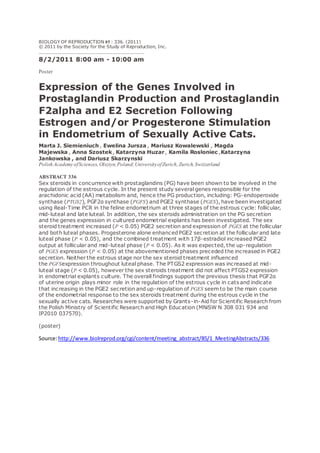More Related Content
Similar to Poster M. J. Siemieniuch
Similar to Poster M. J. Siemieniuch (20)
Poster M. J. Siemieniuch
- 1. BIOLOGY OF REPRODUCTION 85 : 336. (2011)
© 2011 by the Society for the Study of Reproduction, Inc.
8/2/2011 8:00 am - 10:00 am
Poster
Expression of the Genes Involved in
Prostaglandin Production and Prostaglandin
F2alpha and E2 Secretion Following
Estrogen and/or Progesterone Stimulation
in Endometrium of Sexually Active Cats.
Marta J. Siemieniuch, Ewelina Jursza , Mariusz Kowalewski , Magda
Majewska , Anna Szostek, Katarzyna Huzar, Kamila Rosloniec ,Katarzyna
Jankowska , and Dariusz Skarzynski
Polish Academy ofSciences,Olsztyn,Poland;UniversityofZurich,Zurich,Switzerland
ABSTRACT 336
Sex steroids in concurrence with prostaglandins (PG) have been shown to be involved in the
regulation of the estrous cycle. In the present study several genes responsible for the
arachidonic acid (AA) metabolism and, hence the PG production, including: PG-endoperoxide
synthase (PTGS2), PGF2α synthase (PGFS) and PGE2 synthase (PGES), have been investigated
using Real-Time PCR in the feline endometrium at three stages of the estrous cycle: follicular,
mid-luteal and late luteal. In addition, the sex steroids administration on the PG secretion
and the genes expression in cultured endometrial explants has been investigated. The sex
steroid treatment increased (P < 0.05) PGE2 secretion and expression of PGES at the follicular
and both luteal phases. Progesterone alone enhancedPGE2 secretion at the follicular and late
luteal phase (P < 0.05), and the combined treatment with 17β-estradiol increased PGE2
output at follicular and mid-luteal phase (P < 0.05). As it was expected, the up-regulation
of PGES expression (P < 0.05) at the abovementioned phases preceded the increased in PGE2
secretion. Neither the estrous stage nor the sex steroid treatment influenced
the PGFSexpression throughout luteal phase. The PTGS2 expression was increased at mid-
luteal stage (P < 0.05), however the sex steroids treatment did not affect PTGS2 expression
in endometrial explants culture. The overall findings support the previous thesis that PGF2α
of uterine origin plays minor role in the regulation of the estrous cycle in cats and indicate
that increasing in the PGE2 secretion and up-regulation of PGES seem to be the main course
of the endometrial response to the sex steroids treatment during the estrous cycle in the
sexually active cats. Researches were supported by Grants-in-Aid for Scientific Research from
the Polish Ministry of Scientific Research and High Education (MNiSW N 308 031 934 and
IP2010 037570).
(poster)
Source:http://www.biolreprod.org/cgi/content/meeting_abstract/85/1_MeetingAbstracts/336
